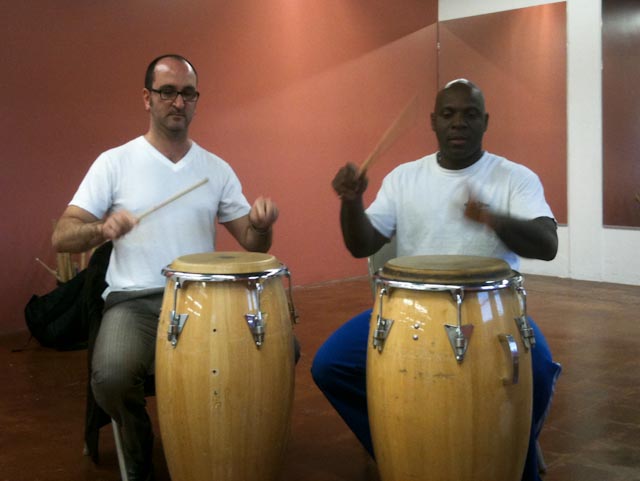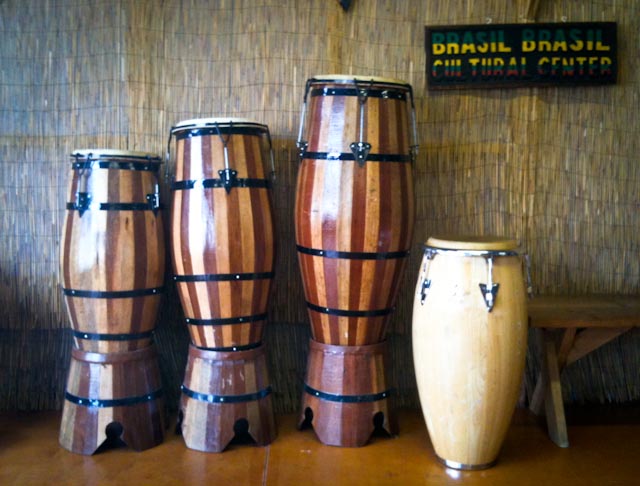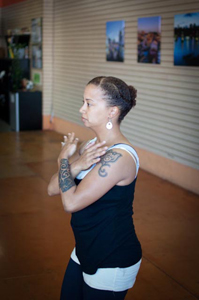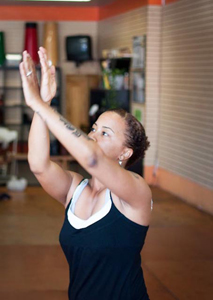
(Beto González and Mestre Amen Santo)
I am thrilled that Mestre Amen’s BBCC/Capoeira Batuque has found a new home. The new space is about twice the size of the old location, beautiful, airy, and bustling with energy and creativity! Mestre Amen and I continued our lessons after a pause for him to pursue the new space, travel, and make preparations for the upcoming capoeira graduation ceremony in June.
The break allowed me some time to reflect on what I have learned so far, where I would like to go, and to realize how little I still know. The candomblé repertory is so vast, I will only be scratching the surface after this year’s apprenticeship. I have also confirmed to myself that learning the basic rhythms of the canon is only part of the process, and it is actually the easy part. After learning the various rhythms, the context for which each one is played (or for which specific orixá, or deity, a rhythm is played for), and learning two of the three parts, there is still the lead parts and the vocals to consider. As I have found (probably not to Mestre Amen’s surprise), even the basic repertory takes many, many months to learn, and years to master.
The candomblé rhythms are played on a set of three atabaques, which are conical drums of West/Central African origin. They are not unlike the familiar congas, and in fact, we often use congas instead for reasons I will outline below. The complete set of atabaques are tuned in three pitches (as are congas). However, where the congas are sized differently by the diameter of the shell but the same height, the atabaques are sized differently in both diameter and height. The atabaque (low to high or large to small) are called rum (pronounced “hoom”), rumpi (“hoom-PEE”), and rumlê or just lê (“hoom-LEH”).

(set of Umbanda atabaques, from left to right: lê, rumpi, and rum, next to a conventional conga drum)
Playing with congas, as opposed to the traditional atabaques, allows us to sit more comfortably, whereas we would have to stand or sit in high stools to play the atabaques. The congas also allow for easier tuning, and better sound control. The artisanal atabaques in the photo were purchased in Rio some years ago and are actually from the Umbanda tradition, which is a highly syncretic variant of candomblé that fuses Catholicism, Kardecian Spiritism, and indigenous lore, and is sung in Portuguese. Umbanda is much more prominent in Rio than in Mestre Amen’s hometown, Salvador da Bahia, and thus why I was able to easily find these rather than the atabaques found in Bahia, which are a bit smaller in diameter. Aside from the use of congas we also often resort to the use of regular drumsticks instead of the traditional agdavi, sticks made from long, thin branches. Commercial drumsticks are more readily available, are consistent in size, and don’t break as easily. There’s actually another interesting reason for using thicker, heavier drumsticks. Playing the rhythms with these is harder and more fatiguing to your arms, but when you switch to the thin and light agdavi, they feel so light!
The parts I have been learning are played on the small and medium drum, rumpi and lê. The lowest pitched rum is reserved for playing the lead parts of the master ogãn (master drummer). Though I am still far from being able to partake in learning the lead parts, on occasion, Mestre Amen insists that I try playing the lead parts. For the rhythms that are played with sticks (the Yoruba-based rhythms for the most part) both the rumpi and lê parts are identical, with the lead rum doing variations based on the orixá’s (interpreted by the dancer) movement. For the rhythms that are played with the hands (the Candomblé de Angola rhythms, or the secular rhythms of Bantu origin such as samba de roda) there are usually distinct parts for both the rumpi and lê, with the rum again doing the lead parts.
In order one to learn the lead parts, it is essential to watch how dancers interpret the movement of the orixás. I have sat in on drums (playing support parts only, never the lead drum) for dance classes many times in the past. But now that I am more consciously trying to learn the rhythmic patterns that echo the footsteps and gestures of the orixás, I have watched dancers with a different perspective.


(Shelby Williams-González dancing orixás)
I am looking forward to our upcoming performance at Capoeira Batuque’s batizado (“baptism” or graduation ceremony) later this month. I will be joining several of my musical cohorts and capoeira colleagues with Mestre Amen in a repertory dedicated to the orixás Xangô, Iansã, Oxum, Ogum, Omolu, and Oxóssi.
